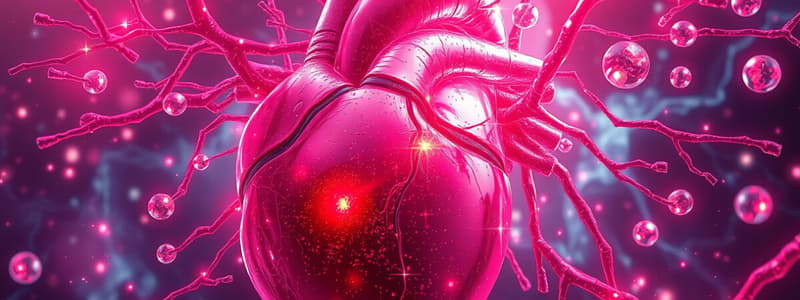Podcast
Questions and Answers
What is the primary therapeutic use of dobutamine?
What is the primary therapeutic use of dobutamine?
- Sinus decongestant
- For treatment of bradycardia
- Antidote for anticholinesterase poisoning
- For cardiogenic shock and heart failure (correct)
Which of the following is a common side effect of atropine?
Which of the following is a common side effect of atropine?
- Pulmonary edema
- Dry mouth (correct)
- Hypertension
- Hypokalemia
What nursing action is critical when administering pseudoephedrine?
What nursing action is critical when administering pseudoephedrine?
- Monitor potassium levels
- Administer without concern for hydration
- Increase dietary sodium intake
- Limit administration to no more than 7 days (correct)
What is a significant contraindication for atenolol?
What is a significant contraindication for atenolol?
What is the primary action of albuterol?
What is the primary action of albuterol?
How does pyridostigmine function in treating myasthenia gravis?
How does pyridostigmine function in treating myasthenia gravis?
Which of the following is a potential adverse effect of albuterol?
Which of the following is a potential adverse effect of albuterol?
What should be monitored after administering atropine?
What should be monitored after administering atropine?
What is the primary therapeutic use of Dopamine at low doses?
What is the primary therapeutic use of Dopamine at low doses?
Which side effect is associated with the use of Epinephrine?
Which side effect is associated with the use of Epinephrine?
What nursing action is especially important when administering Norepinephrine?
What nursing action is especially important when administering Norepinephrine?
What mechanism of action does Doxazosin primarily utilize?
What mechanism of action does Doxazosin primarily utilize?
What is a common adverse effect of high doses of Dopamine?
What is a common adverse effect of high doses of Dopamine?
In which situation is it important to monitor for orthostatic hypotension due to a medication?
In which situation is it important to monitor for orthostatic hypotension due to a medication?
What is the onset time for Epinephrine when administered subcutaneously?
What is the onset time for Epinephrine when administered subcutaneously?
What serious risk is associated with administering Norepinephrine?
What serious risk is associated with administering Norepinephrine?
Flashcards are hidden until you start studying
Study Notes
Doxazosin
- Mechanism of Action: Dilates arteries and veins, leading to a rapid reduction in blood pressure.
- Therapeutic Uses: Effective for benign prostatic hyperplasia (BPH) and managing low blood pressure.
- Side Effects/Adverse Effects: Commonly causes dizziness, fatigue, and headaches.
- Nursing Actions: Administer at bedtime, monitor older adults for orthostatic hypotension, caution during pregnancy.
Epinephrine
- Mechanism of Action: Activates beta-1 and beta-2 adrenergic receptors, causing vasoconstriction and opening airways.
- Therapeutic Uses: Primarily used for anaphylaxis and shock.
- Side Effects/Adverse Effects: Can lead to tremors, palpitations, tachycardia, dizziness, headaches, and may cause paradoxical bronchospasm.
- Evaluate Effectiveness: Blood pressure rises almost immediately due to stimulation of alpha and beta receptors.
- Nursing Actions: Onset is 3-5 minutes via subcutaneous (SQ) and 5-10 minutes via intramuscular (IM); risks of serious tissue injury if extravasated.
Norepinephrine
- Mechanism of Action: Nonselective adrenergic agonist; causes vasoconstriction and increases blood pressure, with beta-1 activity enhancing cardiac output.
- Therapeutic Uses: Primarily used as a vasoconstrictor in septic shock.
- Side Effects/Adverse Effects: Includes dysrhythmias, hypertension, and necrosis at the IV site. Phentolamine is used as an antidote for extravasation.
- Evaluate Effectiveness: Increased cardiac output observed.
- Nursing Actions: Monitor blood pressure and heart rate, use a dedicated IV site, and do not abruptly stop the infusion.
Dopamine
- Mechanism of Action: Low doses stimulate dopaminergic receptors for renal vasodilation; higher doses stimulate beta-1 for increased heart force and alpha-adrenergic for vasoconstriction.
- Therapeutic Uses: Used in shock management, especially for hypovolemic and cardiogenic types.
- Side Effects/Adverse Effects: May cause hypertension and dysrhythmias, with a concern for extravasation.
- Evaluate Effectiveness: Onset is less than 5 minutes with a duration of under 10 minutes.
- Nursing Actions: Continuously monitor for dysrhythmias and hypertension.
Dobutamine
- Mechanism of Action: Selectively stimulates beta-1 adrenergic receptors with minor blood pressure effects.
- Therapeutic Uses: Indicated for cardiogenic shock and heart failure.
- Evaluate Effectiveness: Acts as a cardiac stimulant.
- Nursing Actions: Administer IV, monitor blood pressure, heart rate, ECG, cardiac output, urine output, and potassium levels; may induce hypokalemia.
Atropine
- Mechanism of Action: Blocks parasympathetic ACh actions; promotes fight-or-flight responses including increased heart rate and bronchodilation.
- Therapeutic Uses: Treats bradycardia and acts as an antidote for anticholinesterase poisoning (e.g., Donepezil, Neostigmine).
- Side Effects/Adverse Effects: Can cause dry mouth, constipation, urinary retention, increased heart rate; initial CNS excitement may progress to delirium or coma.
- Nursing Actions: Monitor blood pressure, pulse, and respirations before administration and for at least one hour post-dose.
Pseudoephedrine
- Mechanism of Action: Indirectly stimulates alpha-adrenergic receptors and directly stimulates beta-adrenergic receptors.
- Therapeutic Uses: Functions as a sinus decongestant.
- Side Effects/Adverse Effects: Can lead to tachycardia and palpitations.
- Evaluate Effectiveness: Observed decongestion of sinuses.
- Nursing Actions: Limit use to under seven days; recommend fluid intake of 2-3 liters per day, monitor for adverse effects.
Albuterol
- Mechanism of Action: Acts as a beta-2 adrenergic agonist.
- Therapeutic Uses: Functions as a bronchodilator.
- Side Effects/Adverse Effects: Monitors for palpitations, headaches, throat irritation, tremors, nervousness, restlessness, and tachycardia.
- Evaluate Effectiveness: Airway dilation leads to easier breathing.
- Nursing Actions: Monitor heart rate and respiratory function.
Beta-Adrenergic Blockers (Atenolol/Metoprolol)
- Mechanism of Action: Blocks beta-1 adrenergic receptors.
- Therapeutic Uses: Used for angina, myocardial infarction (MI), and hypertension.
- Contraindications: Avoid in patients with severe bradycardia, AV heart block, cardiogenic shock, or severe hypotension.
Cholinergic Medications (Pyridostigmine)
- Mechanism of Action: Inhibits acetylcholinesterase, preventing breakdown of acetylcholine.
- Therapeutic Uses: Primarily used for managing myasthenia gravis, a neuromuscular disorder.
Studying That Suits You
Use AI to generate personalized quizzes and flashcards to suit your learning preferences.

